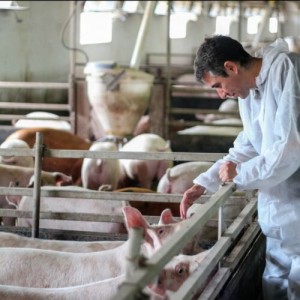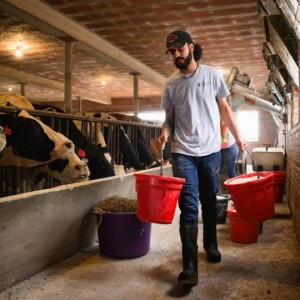The United Kingdom notifies a case of contagion of bird flu to a person
Despite the fact that transmission of bird flu to humans is very rare and has previously only occurred on a few occasions in the country, the UK Health Security Agency has reported a case of infection in a person in the southwest of England. The affected person was infected by very close and regular contact with a large number of infected birds, which he kept in and around his house for a prolonged period.
All of the person's contacts, including those who visited the facility, have been traced and there is no evidence the infection has spread to anyone else. Currently, the affected person is well and isolated, authorities reported.
Isabel Oliver, scientific director of the United Kingdom Health Security Agency, recalled that although the risk of bird flu for people, in general, is very low, some strains have the potential to spread to humans and that is why they have robust systems to detect them early and take action.
Similarly, he added that there is currently no evidence that this strain detected in the UK can spread from person to person, “but we know that viruses evolve all the time and we continue to monitor the situation closely. this person's contacts and we have not identified any spread."
Circumstance specific
Christine Middlemiss, director of veterinary medicine for the United Kingdom, agreed that the transmission of avian flu from birds to people is very rare and very specific to specific circumstances. She recalled that in the face of the outbreaks that have occurred in the country, rapid measures have been taken to limit the spread of the disease: all infected birds have been humanely euthanized and the facilities are in the process of being cleaned and disinfected.
"We are seeing an increasing number of cases in birds in both commercial farms and backyard poultry across the country. Implementing scrupulous biosecurity measures will help keep your birds safe," Middlemiss said.
The variants worry
Faced with the global expansion of avian influenza, the director-general of the Organization for Animal Health (OIE) Monique Eliot was concerned. As reported by the Reuters agency in an interview, Eliot said that currently the situation caused by bird flu "is more difficult and with more risks, because we see that more variants arise, which makes them more difficult to follow." The director-general of the OIE explained that "over time, the risk is that the virus mutates or mixes with a human influenza virus that can be transmitted between humans and, suddenly, it takes on a new dimension."
The OIE reported that around 850 people have been infected with the H5N1 strain, one of the few that can be transmitted to humans. Of those cases, half died. Last year, several people were infected with the H5N6 strain in China, raising concerns among some experts that a previously circulating strain appears to have changed and maybe more infectious to people.
However, Eliot reminded that most countries have learned to contain outbreaks and that transmissions to humans are sporadic since bird flu is usually transmitted through close contact. "If there are one, two, or three humans infected it is worrying, but you don't need to be too quick to be alarmed about the risks of spread. It will depend on how people have been infected," she explained.
Fifteen countries have reported outbreaks of avian influenza in poultry between October and the end of December, mainly the H5N1 strain. Italy is the most affected country in Europe with 285 outbreaks and almost four million culled birds, according to OIE data.
The most recent case detected in Spain
This week the H5N1 virus has been detected in several wild birds found dead in the Segre River, near the town of Soses, Segriá region, Lleida province. The birds were found by members of the Rural Agents of the Generalitat de Catalunya and the Central Veterinary Laboratory (LCV) of Algete confirmed the presence of the virus in them. However, the communication of this finding in wild birds should not imply commercial restrictions on the movement of live birds or their products, with which Spain maintains the status of officially free of notifiable avian influenza.
The birds, four swans (Cygnus olor) and a stork (Ciconia ciconia), were detected within the framework of the intensification of passive surveillance in wild birds included in the National Avian Influenza Surveillance Program in Spain, as a consequence of the increase in risk given the recent evolution of the epidemiological situation of the disease in northern and central Europe.
Swab samples from birds found dead were sent for analysis to the IRTA-CReSA laboratory, where positive results were obtained by PCR for subtype H5 of the avian influenza virus, results that were confirmed by the National Reference Laboratory for avian influenza. in Spain (LCV de Algete), determining that it is a HPAI H5N1 strain.
Passive surveillance intensifies
Immediately, the body of Rural Agents of the Generalitat of Catalonia and of the Environment of the Government of Aragon have proceeded to intensify the passive surveillance of wild birds in the surrounding area of 10 km around the outbreak, prioritizing the first 3 km.
There are no commercial poultry farms within a radius of 3 km around the outbreak, and the Official Veterinary Services of Catalonia and Aragon are carrying out control visits to the farms located within a radius of 10 km with the aim of verifying:
- The biosecurity measures of the same, correct the possible deficiencies detected.
- Inform those responsible for the birds of the risk and the importance of avoiding contact with wild birds, as well as the immediate communication to the OVS of any suspicion of disease.
- Check the clinical status of the animals, in order to detect any suspicion of infection. When deemed necessary, samples will be taken from the animals to determine avian influenza.
The H5N1 subtype is predominant in the current epizootic wave of HPAI present mainly in northern and central Europe, where from August 1 to December 27, 2021, a total of 1,199 HPAI outbreaks have been reported in 27 countries. , 507 in poultry and 692 in non-poultry, including wild, of which 1,051 were of the H5N1 subtype.
Given the evolution of the epidemiological situation in Europe, on December 2, the analysis of the risk of introducing the virus into our country carried out by the MAPA was updated, resulting in a high risk in the municipalities included as a special risk area. in annex II of Order APA/2442/2006, and moderated in the municipalities included in the special surveillance zone in annex III of said Order, for which additional measures were adopted to prevent possible outbreaks of the disease.
Biosecurity measures
Taking into account the confirmation of the presence of the HPAI H5N1 virus in wild birds in the municipality of Soses, the situation of the disease in neighboring countries, with the presence of the virus in domestic farms in Portugal and the south of France, the risk of introduction and circulation of the HPAI virus, especially the H5N1 subtype, in Spain can be considered very high in areas of special risk and high in areas of special surveillance, for which reason it has been decided to equate biosecurity measures to apply in areas of special risk and in areas of special surveillance throughout the country. In particular:
- a) The use of birds of the Anseriformes and Charadriiformes orders as decoys are prohibited.
- b) The breeding of ducks and geese with other species of poultry is prohibited.
- c) The rearing of poultry in the open air is prohibited. However, when this is not possible, the competent authority may authorize the keeping of poultry in the open air, by placing, if possible, aviaries or any other device that prevents the entry of wild birds, and always that the birds are fed and watered inside the facilities or in a shelter that prevents the arrival of wild birds and prevents their contact with food or water intended for poultry.
- d) It is forbidden to give water to poultry from water tanks that can be accessed by wild birds, except in the event that this water is treated in order to guarantee the inactivation of possible avian influenza viruses.
- e) The water tanks located outside required for reasons of animal welfare for certain poultry, will be sufficiently protected against wild waterfowl.
- f) The presence of poultry or other types of captive birds in the animal concentration centers defined in article 3.7 of Law 8/2003, of April 24, on animal health is prohibited, including livestock events, samples, cultural exhibitions, and celebrations, as well as any concentration of poultry or other types of captive birds in the open air.














List
Add
Please enter a comment